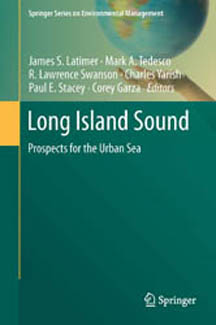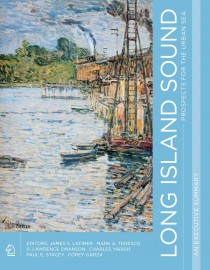LISS Announces Publication of New Science Book Synthesizing Decades of Long Island Sound Research
 Contact: Robert Burg, LISS Communications Coordinator, 203-977-1546/burg.robert@epa.gov
Contact: Robert Burg, LISS Communications Coordinator, 203-977-1546/burg.robert@epa.gov
Stamford, CT, Dec. 9—The Long Island Sound Study (LISS) announces that the most comprehensive review and synthesis of scientific research of the Long Island Sound in 35 years is now available as a book published by Springer, a global publisher of science books. Long Island Sound: Prospects for the Urban Sea was written by scientists, resource managers, and historians, working with LISS, who gathered nearly 1,500 research papers to summarize what is known about the historic and recent trends of the ecological health of Long Island Sound. Six technical chapters describe the Sound’s human history, geology, physical oceanography, geochemistry, pollutant history, and biology and ecology. A seventh chapter details the cross-cutting issues and the complex interrelationships between different environmental and socio-economic trends to help provide guidance to planners, environmental managers, and policy makers on how to manage coastal waters such as the Sound.
“Synthesizing decades of research into one volume will be of enormous value for environmental managers and policy makers,” said James S. Latimer, a research scientist with the US Environmental Protection Agency, and the lead editor on the volume. “They will have access to knowledge from the best research available about the Sound as they make critical decisions on protecting natural resources valued by citizens and vital to the region’s economy.”
Among the new and enduring challenges addressed in the book’s technical chapters and synthesis chapter are climate change, coastal development and use conflicts, fisheries management goals, emerging contaminants, invasive species, and nutrient pollution.
“This massive, multidisciplinary synthesis is a welcome contribution to the understanding of Long Island Sound, providing not only new knowledge, but important information relevant to managers of coastal ecosystems,” said Gene E. Likens, founding director and president emeritus of the Cary Institute of Ecosystem Studies in Millbrook NY, in a comment that appears on Springer’s website. “It will provide an extremely valuable resource for Long Island Sound for many years to come.”

As described in the book’s preface, the Science and Technical Advisory Committee of the Long Island Sound Study identified the need for a synthesis of new science on the Sound, and first developed an outline of the book at a workshop. The LISS, part of the National Estuary Program and charged with restoring and protecting the Sound, had developed a Comprehensive Conservation and Management Plan in 1994. But the science upon which the plan was based was approaching 20 years old and the management lexicon of the time didn’t even include climate change. The US Environmental Protection agency provided funding for the development of the book through cooperative agreements with the Connecticut and New York Sea Grant Programs.
Besides Latimer, the book’s other editors are: Mark A. Tedesco, director of the EPA Long Island Sound Office in Stamford; R. Lawrence Swanson, a professor at the School of Marine and Atmospheric Sciences at Stony Brook University; Charles Yarish, a professor at the Department of Ecology and Evolutionary Biology at the University of Connecticut in Stamford; Paul E. Stacey, a research coordinator at the Great Bay National Estuarine Research Reserve in Durham, NH; and Corey Garza, a professor at the Division of Science and Environmental Policy at California State University in Monterey Bay, CA.
The book is part of Springer’s Series on Environment and Management. It’s available in e-book either in its entirety or by individual chapter on the publisher’s website at springer.com. The hardcover version can be pre-ordered on the Springer website or other booksellers.
Long Island Sound, which has been described as “The Urban Sea,” is an estuary that provides economic and recreational benefits to millions of people, while also providing habitat for more than 1,200 invertebrates, 170 species of fish, and dozens of species of migratory birds. LISS is a cooperative effort between the EPA and the states of Connecticut and New York to restore and protect the Sound and its ecosystem. To learn more about LISS, visit www.longislandsoundstudy.net.
LISS also has published an eight-page summary of the book posted in the LISS media center.
-30-